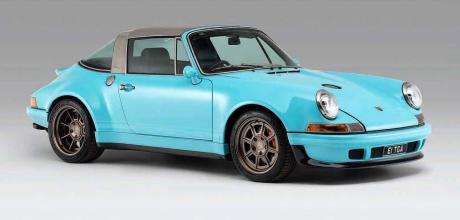Turkish Blue 1992 Porsche 911 Carrera 4 964 restomod
It’s one of the most amazing backdates to grace these pages for a very long time, althoughyou’d be hard-pressed to guess this eye-popping 911 started life as a 964 Carrera 4 Targa...
Words Johnny Tipler
Photography Gunhill Studios
TARGA SAGA
A Turkish Blue 1992 Porsche 911 Carrera 4 964 restomod
On the face of it, there are plenty of reasons not to meddle with a 964. Sure, time was, they lingered in the desirability doldrums. Back then, everyone wanted a long-bonnet classic. Now, though, this generation of 911 is highly sought after. Values have skyrocketed accordingly. I thought I was doing well getting twice what I paid for the Peppermint Pig when I sold it in 2016, but I weep when I see what a 964 of its calibre is worth today.
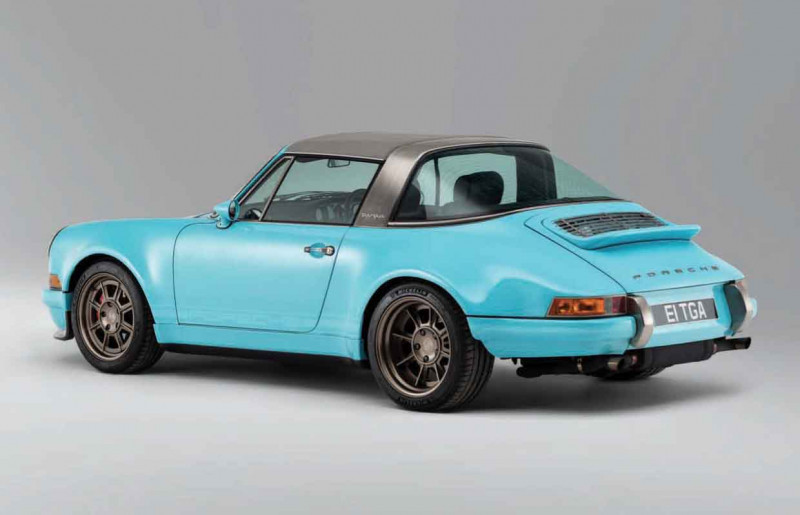
Generally speaking, buyers want standard specification 911s. With values as they are, why would you compromise originality by altering a 964 and turning it into a full-blown backdate? Granted, Rob Dickinson would no doubt give you a decent price for your standard 964 in order for it to be transformed into one of Singer Vehicle Design’s next showpieces, but going for a song? I don’t think so. Anyway, to the case in point. Is it a restomod?
Possibly, seeing as there was a little bit of repair work involved in the process. Enough of the semantics. What we have here is a 964 backdate, pure and simple. And an amazing looking one at that. I can’t think of anything so radical, especially in the cabin. A vast amount of work has taken place across the board.
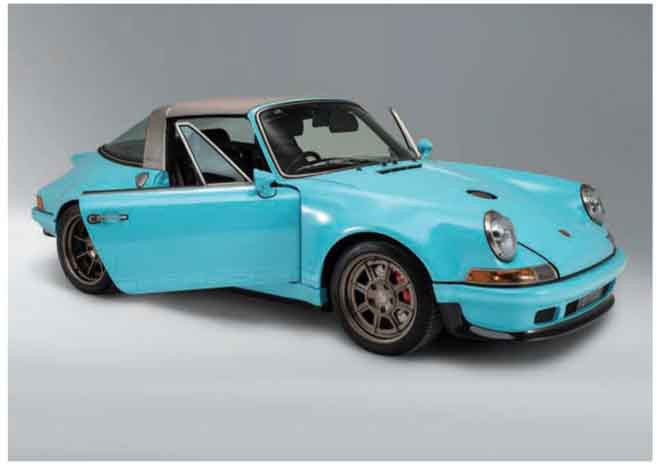
Here comes the next eyebrow raiser: it’s a Targa. Surely, you might argue, if you’re going to invest a significant sum of cash in a backdate conversion, you’re going to start with a coupe, rather than the slightly unfashionable — dare I say unloved — Targa? Blame the kids. The car’s owner, Danny Witte, was already in possession of this semi-open top classic 911 before the transformation began.
The car started life as a black 1992 964 Carrera 4 Targa, which he liked well enough. His three boys (aged eight, ten and eleven) loved it. They especially liked having the Targa roof off when ensconced in the back seats. Unlike a roadster or cabriolet, the Targa — as its Sicilian name suggests — provides extra shielding around the cockpit by way of a distinctive roll-hoop and greenhouse rear window, bestowing a feeling of security on the car’s occupants. While Danny likes the Targa body style, he admits he isn’t totally smitten with the overall look of the 964. He enjoyed the way his car drove, certainly when compared with his earlier Carrera 3.2, and he is a fan of the 964’s stock-spec normally aspirated 3.6-litre boxer, but he was never sold on the 964’s attempt to bridge the worlds of ancient and modern through updated looks. Of course, many enthusiasts love the 964 for precisely this reason.
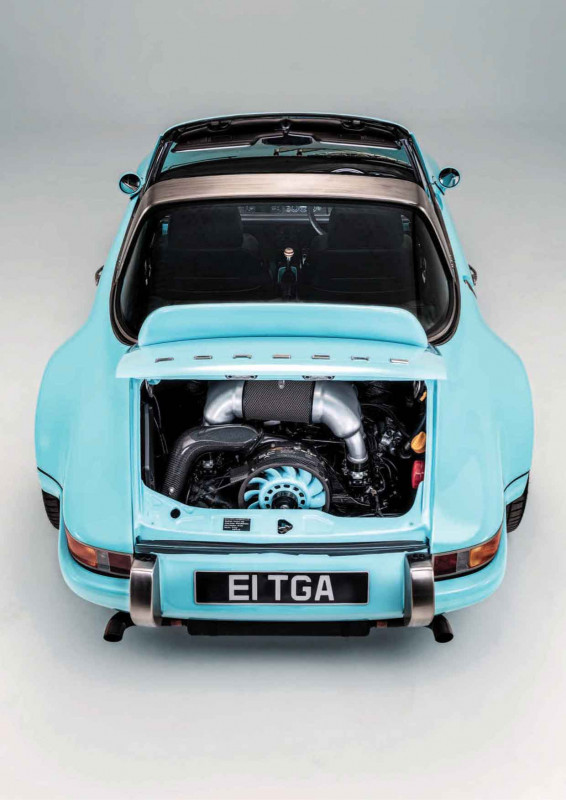
Danny sought out independent Porsche restoration and accessories outfit, Stuttgart Classica, based at Moreton-in-Marsh, where he thrashed out a plan of action with company boss, Will Chappell. “Danny approached us with a request for a custom build,” Will recounts. “He had a pretty good idea of what he wanted, which always helps. He likes the fact that the 964 is quite a bit more modern than its predecessors. Already owning this generation of 911 gave him a head start when it came to mapping out the specification he desired for the finished build, which took near eighteen months from start to finish, though this included delays in trimming the Targa roof due to the service provider, Southbound Trimmers, being very busy with a long line of existing customer work.”
IT RETAINS ITS TARGA TOP AND THE OVERALL RETRO LOOK WORKS WELL WHEN, IN TRUTH, IT PROBABLY SHOULDN’T
Meanwhile, there was plenty to be getting on with — corrosion was evident after the car was stripped. “We weren’t really battling rust,” declares Will, “but there are specific issues you need to be aware of when working on a 964. It’s mainly the condition of sills and floor panels, which can be poor on a Targa if the roof has been leaking.” Most do. Also, the sill covers can rot as a consequence of dirt holding moisture between them and the bodyshell. This is all relative because, as Will says, “it’s not anywhere as bad as you’ll likely find with an F- or G-series 911.”
RAISE THE ROOF
Defective window seals are also known for letting water into the cabin, especially around the rear greenhouse window. “Air-cooled 911 Targa roofs aren’t like you’ll find on a modern drop-top,” says Will. “Even when you have them retrimmed, you’re almost certainly going to experience water ingress. Soggy carpets lead to rust, and though we were lucky insofar as Danny’s 964 was in excellent condition, there is a fair amount of metalwork involved in backdating a 964 to mimic the look of a 911 manufactured in the early 1970s, regardless of the quality of the host Porsche.”
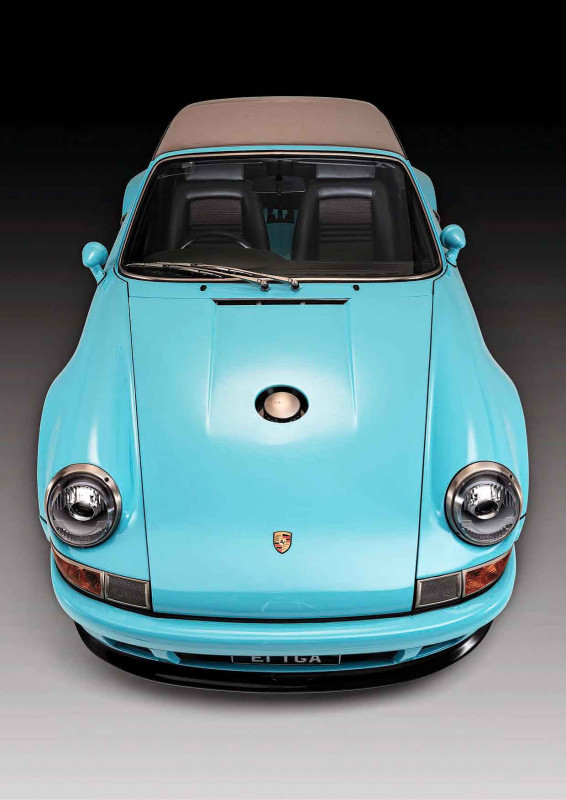
Visually, this is a knockout 964. It retains its Targa top, obviously, and the overall retro look works well when, in truth, it probably shouldn’t. There’s reference to competition heritage, too — take a look at the central bonnet fuel filler.
Will reckons the biggest operation was the engine. “This part of the project took the longest. We got through the metalwork and paintwork stages of the build relatively quickly, but many of the required engine components were subject to a frustratingly long lead time.” I’m as keen as the next Porsche owner to fiddle around with their car, but Danny went the whole hog — not only did the look of his 964 Carrera 4 Targa get backdated, the flat-six transmuted from a 3.6 to a 3.8.
BACK IN THE GAME
Perverse? If you’re backdating a car, shouldn’t the power unit be backdated, too?! No, of course not, but it is a question worth asking. “Danny gave the green light to pretty much every suggestion we had for his car, save for an upgrade to four litres of displacement,” Will recalls. “In fairness, it is an eye-wateringly expensive conversion and, in terms of bang for your buck, it isn’t particularly good value for money. Don’t get me wrong, the engine rebuild we settled on was by no means cheap, but we’ve got perfectly good additional power and torque from oversizing to 3.8 litres. This car hauls like a freight train! You’d need to spend another thirty to fifty grand to get the extra twenty ponies offered by a four-litre flat-six.” Danny was clear: he didn’t want a motorsport engine, chiefly because his Targa was destined to continue serving as a family car. Instead, he wanted his 964 to be powered by an oversized boxer he could use on a daily basis without having to give thought to the potentially temperamental behaviour of a race oriented flat-six. For this reason, Stuttgart Classica concentrated on the enlarged unit’s drivability.
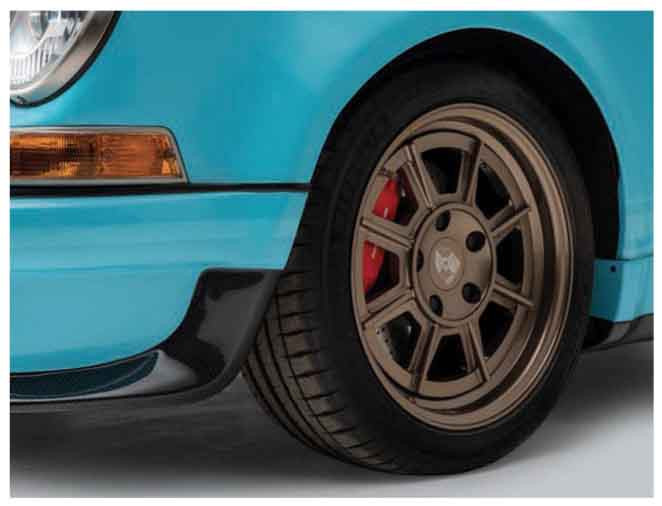
Will teamed up with Wallingford-based Porsche engine specialist, WrightTune, to partner on the project. “I went to Wrightune with an outline of the specification we wanted. Company director, Chris Wright, advised on which parts would be compatible with one another. For example, he was able to recommend the perfect match of pistons, barrels and connecting rods. He helped us select a winning combination of components able to work in harmony with one another.”
The casings were vapour-blasted, de-studded and replated. All new tinware shrouds were called into action, as were Mahle motorsport 3.8-litre pistons and barrels, Carrillo rods, ARP fasteners, Dougherty camshafts and a spectacular-looking GT3 plenum with central oval air filter specially manufactured by ITG. The finished engine was mapped by Neil Bainbridge at BS Motorsport, registering 373bhp and a useful 299.8lb-ft of torque.
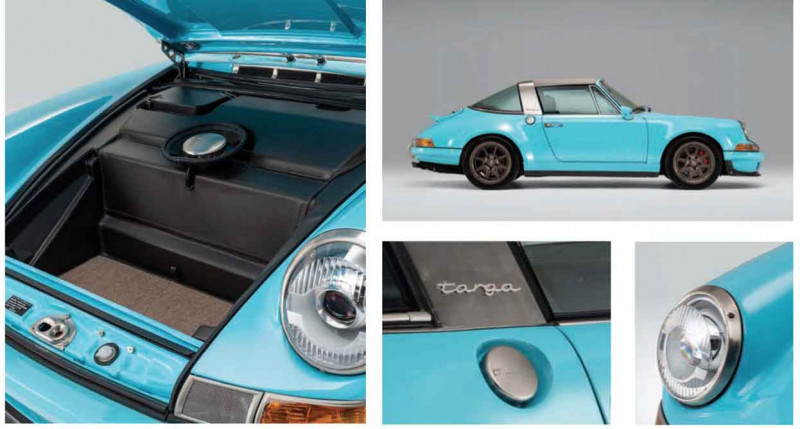
A Motec ECU is located under the passenger seat. The engine fan is colour-coded, the serpentine belt upgraded. Carbon heater tubes and coil lead covers are in effect. Braided fuel hoses run from tank to engine. Stuttgart Classica rebuilt the gearbox with new synchros, bearing and seals after vapour-blasting the case. A limited-slipper was already in place. New rear driveshafts were fitted, but the fronts — this is a Carrera 4, don’t forget — have been on order from Porsche for two years. A bit of a heads-up on Wrightune. It’s essentially a father-and-son operation, established by Tony Wright and run by Chris, aided by trusty spanner men, Mike and Joe. Back in the mid-1970s, Tony (now pretty much retired) spent two years with JW Automotive building Ford Cosworth DFV engines for the highly successful Le Mans winning Gulf Mirage team. After a spell at Langland Motor Company in Kensington, he joined Dage Sport, which subsequently became G-Force Motorsport. After more than fifteen years with G-Force principal, John Greasley, Tony decided to start his own Porsche only workshop. Wrightune was born.
As for Stuttgart Classica, the firm has been going since 2016 and stems from Will’s family business in car sales. “My dad is heavily into Porsches and focused on the sale and servicing of Zuffenhausen’s output in the 1980s and 1990s. Stuttgart Classica was created by myself and my business partner, Jason Eaton. He runs the US arm of the business and I manage UK orders, as well as those for the rest of the world outside Great Britain and North America.” The operation is split between the design, production and sale of bespoke parts (representing fifty percent of trade) and made-to-order Celette bench jig restorations, including projects such as this 964 Targa backdate. “We don’t sell standard replacement parts,” Will comments. “We offer accessories and performance upgrades not available anywhere else. Our parts are bespoke and out of the ordinary. We are, of course, able to deliver straight-up Porsche restorations, but this isn’t why people come to us. Stuttgart Classica is where you bring your 911 if you want something different to the norm.”
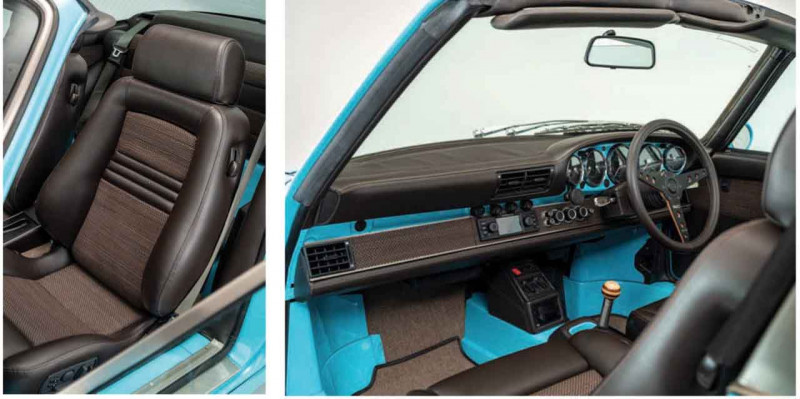
What a fabulous colour choice! The Targa is finished in Teurkis 340 (Turkish Blue), a hue used on a handful of 911s during the 1970 and 1971 model years. As an aficionado of 964s in standout colours — vis. The Peppermint Pig — I wholeheartedly applaud Danny’s choice. He did, in fact, once own an old Volkswagen finished in very similar colour, back when his family firm ran a VW parts business. He also owned a 993 Turbo, but his kids were having more fun in the Targa. As a result, the 993 was sold to fund the build seen here.
IT RETAINS ITS TARGA TOP AND THE OVERALL RETRO LOOK WORKS WELL WHEN, IN TRUTH, IT PROBABLY SHOULDN’T
Look closely and you’ll see all brightwork has been dull nickel-plated with a brushed finish. The wheels are staggered seventeen-inchers manufactured by Augment Wheels and styled on period Campagnolos. The arches are flared to mirror the look of those worn by the 964 Turbo. The front wings were replaced with early 911 panels, matched to a long bonnet mounted with Stuttgart Classica aluminium hinges.
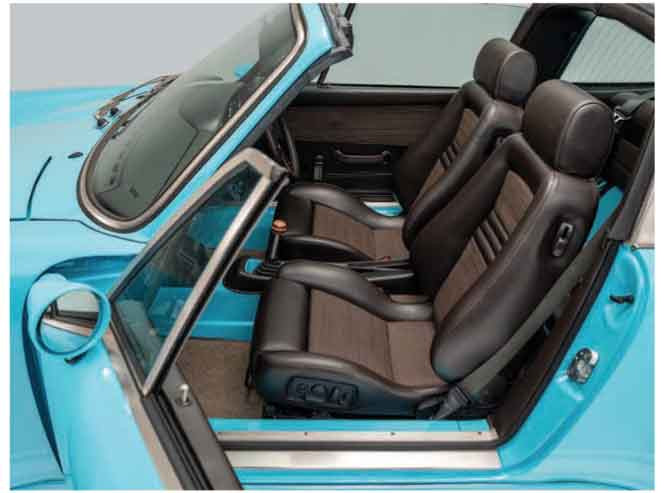
In fact, the specification of this 964 reads like a Stuttgart Classica parts catalogue. For starters, you’re looking at one of the firm’s carbon-fibre front bumpers (the top half is painted body colour), as well as an exposed carbon splitter and bespoke carbon-fibre sill covers. The latter were custom-developed for this particular project. The lower portion of each cover features exposed carbon (lacquered), while the upper section is body-coloured. Each cover is of a single-piece construction allowing for a backdated look without having to replace the 964’s sills.
ALIGN OF DUTY
Carbon-fibre was also used for the rear bumper corners. The bumper itself is a three-piece construction allowing for full adjustment at each side of the car for a perfect fit, helped by bespoke Stuttgart Classica bumper mounts. The door mirrors are also finished in body colour, which is a first for these parts — they are usually only presented on Stuttgart Classica’s projects with either a nickel-plate or black finish. The exaggerated rear spoiler and grille assembly retain the standard deployment motors elevating the spoiler at 50mph. Another sophistication is the side-mounted oil filler, which is fully functional in coordination with the 964 oil tank. The billet filler lid is inscribed in the appropriate Porsche typeface. The aluminium centre-fill fuel tank boasts ninety litres of capacity, but open the front lid and you’re presented with a very different environment to the front end of a standard 964 — or any 911, for that matter — because it’s lined with a Stuttgart Classica frunk liner, allowing for organised storage of the removed Targa top. Also prominent is a Stuttgart Classica aluminium strut brace. 9eleven Raven S LED headlights are embraced by headlight rings with the now familiar dull nickel finish. They were supplied to Danny with a pair of body-coloured rings for good measure. Also fitted are Stuttgart Classica’s own mesh horn grilles and a 993 windscreen wiper assembly with centre-mounted wiper arms. All light cluster borders have been painted grey to replicate the dull nickel finish of the brightwork.
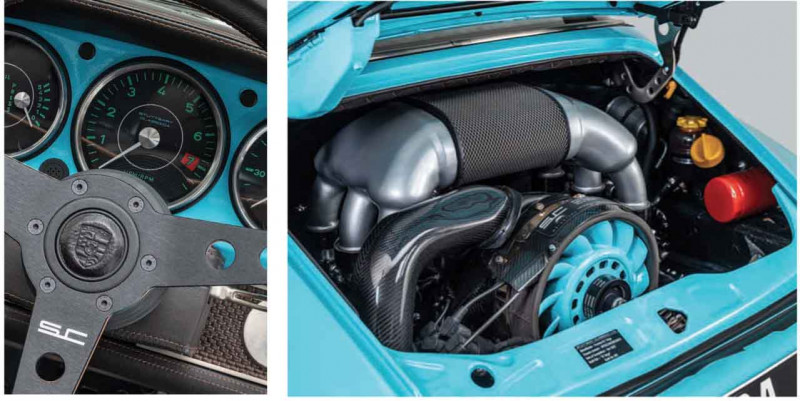
The Targa lid was retrimmed in GC 955 Grey Beige. A measure of how thoroughly the task was undertaken is highlighted by the backdated front and rear window panes, complete with decorative dull nickel inserts. All internal retrimming was carried out by the talented team at Awesome Classic & Custom, located near Huntingdon. The work represents just as much of a fundamental a change to this 964’s identity as the backdating of the exterior.
Greg Ward, head trimmer and co-owner of Awesome Classic & Custom, confirms the car’s reimagined cabin centres around the installation of a Stuttgart Classica carbon-fibre tub lining the entire cockpit, forming the walls thereof and presented in body colour. “The car came to us as a rolling shell last year,” he remembers. “We spent two months working on the interior. The cabin linings are finished in chocolate brown handwoven hide, which is Vele Bournville from the Crest leather range. We bonded it to the necessary backing material, which wasn’t the easiest to work with. You have to be careful to get the lines straight, as in across the back of the seats, else the finish can look decidedly amateur.”
Vele Bournville produces a calming effect against the bright body colour of the dashboard. “Danny gave us lots of leeway,” Greg continues. “Given free reign, you can go mad with a project like this, but it’s important not to go beserk.” The most challenging part of the interior? “The bits nobody really sees, such as the box in front of the gear lever,” he smiles.
The seats are electrically adjustable Recaro Ergomeds ES recliners and provide both heating and cooling functionality. “We reprofiled the headrests in order to give an appearance akin to that of early Recaro sports seats,” Greg reveals. “The carpets are charcoal square-weave mats, with the design mirrored in the seat centres and lower dashboard strip.” The in-house manufactured switch panel incorporates all the 964 knobs and switchgear, impressively deployed in typical classic 911 fashion, and includes a full-colour touchscreen for the appointed TracTive semi-active suspension system. TracTive’s Active Controlled Electronics (ACE) dampers are fitted with patented Dynamic Damping Adjustment (DDA), a dynamic proportional valve operating as a bypass, allowing capacity for an unusually large range of damping. Capable of operating from soft to hard in a barely believable six milliseconds, a TracTive ACE system is one of the fastest aftermarket suspension solutions available.
ACE has an intuitive ability to react to changing track surfaces and road conditions. Bumps, compressions and rumble strips mid-corner will be absorbed before the driver has time to react, easily holding the desired line through a series of high-speed bends. Grip levels in all conditions are vastly increased, giving the ability to push the host Porsche to limits the driver previously thought not possible. Configuration can be achieved by way of an in-cabin rotary switch or a full-colour touchscreen controller, allowing damping presets to be stored and activated in an instant, even when on the move.
At the very least, compare the convenience of a system like this to having to stop the car and crawl around on the floor to fiddle with on-body damper adjusters. Being able to switch between suspension settings on the fly is a huge win for the driver of any car travelling on contrasting surfaces. I’m not talking exclusively about variations between road and track — the standard of UK roads differs wildly from street to street. Being able to soften or stiffen damper rates while the car is moving across changing surfaces (or from one end of a long track to the other) is a luxury no Porsche owner will want to be without after experiencing what a TracTive system has to offer.
On the subject of chassis equipment, all standard aluminium parts were vapour-blasted and equipped with new supporting hardware. H&R anti-roll bars (24mm front and 26mm rear) were fitted alongside adjustable rear drop links, polyurethane bushes and 964 Turbo steering rack control arms. 993 Turbo brakes were installed. The car was then taken to suspension tuning specialist, Center Gravity, for geometry suited to both 911 and driver.
MIX AND MATCH
Continuing our exploration of the cabin, we spot backdated gauges, billet steering column stalks and a Porsche Classic Communication Management (PCCM) head unit, as well as a Classic Retrofit air-conditioning system. Of the other controls, the laser engraved five-speed gear knob is styled after that of the 917 race car. The floorboards exhibit a dull nickel finish, while the seat belts are colour-coded to Awesome’s handiwork.
“I’m not a fan of small steering wheels,” Danny confirms, “which is why I opted for a Tactico Racing Atelier Viceroy.” Just fifty-nine such steering wheels were manufactured. Penned by Porsche buff, Glenn Cordle, the design caught the eye of Sung Kang, best known for playing the character, Han, in the Fast & Furious movies. Kang helped bring the design to reality exclusively for Tactico. Fitted to a removable boss and individually numbered, the wheel is 380mm in diameter, allowing clear view of the dash gauges in classic Porsche fashion — the same size steering wheel was adopted by the Stuttgart squad in the early 1970s, including during production of the 914 and Carrera RS 2.7.
A laminated white ash back (mated to a brushed black aluminium front) provides warmth and gives the Viceroy a unique look when viewed from different angles. For Danny’s car, Tactico finished the rim in brown leather with stitching to match the colour of Greg’s needlework. Make no mistake, El Targa (as this 911 is eloquently known) has received a comprehensive makeover in the hands of experts in their field. Who said you shouldn’t mess with a 964? This open-air Porsche is nothing short of a triumph in the art of backdating.
Above Tactico RA Viceroy steering wheel is one of just fifty-nine examples of its kind Right Most of the car’s carbon-fibre componentry is covered in the gorgeous Tiffany Blue-style hue, but take a look in the engine bay and exposed weave is everywhere you look.
TACTICO FINISHED THE RIM IN BROWN LEATHER WITH STITCHING TO MATCH THE COLOUR OF GREG’S NEEDLEWORK
Above A superb take on a 911 backdate, this all-pawed 964 looks every bit as good as it can propel itself along Danny’s favourite backroads.
Above Retrim extends to the front luggage area, which houses a centre-fill fuel cell and is tidied by a custom ‘frunk liner’, allowing safe storage of the Targa top Right Functional oil filler has been appointed to the rear quarter panel.
Facing page Engine has been comprehensively rebuilt and now boasts 3.8 litres of displacement, as well as one of Stuttgart Classica’s GT3- style carbon intake systems.
Above and below Awesome Classic & Custom did an excellent job of transforming the car’s interior by using softtouch Vele Bournville leather, which is finished with a supersoft pigmented topcoat.
HE DIDN’T WANT A MOTORSPORT ENGINE, CHIEFLY BECAUSE HIS TARGA WAS DESTINED TO SERVE AS A FAMILY CAR
Above Many bespoke components, such as carbon-fibre sill covers, were developed for this 964 Carrera 4 Targa, but are now available to order direct from the Stuttgart Classica website.
Facing page Turkish Blue is a factory colour used sporadically by Porsche in the early 1970s.


